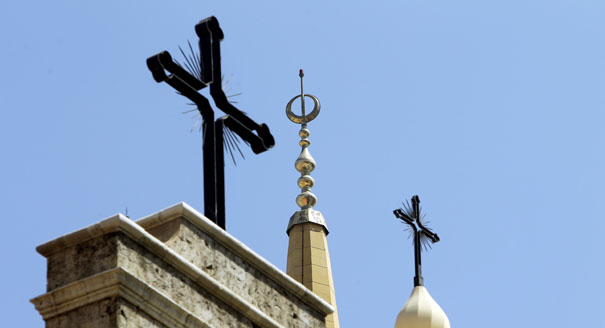In the past year Carnegie has apparently had few illusions about Lebanon’s sectarian power-sharing system. Last year, Visiting Scholar Joseph Bahout wrote a detailed critique of the Lebanese system in a paper titled The Unraveling of Lebanon’s Taif Agreement: Limits of Sect-Based Power Sharing.
Most recently, Maha Yahya, the director of the Carnegie Middle East Center, focused on the crises in the sectarian power-sharing systems of Lebanon and Iraq. Her paper was titled The Summer of Our Discontent: Sects and Citizens in Lebanon and Iraq.
Both authors made very good arguments to show that the Lebanese system has reached a point of paralysis, with politicians largely manipulating sectarianism to maintain their hold on power and preserve their latitude to pillage the country. The grounds for their skepticism were uncontestable. It is very difficult to champion the sectarian system when reality has dismantled its more optimistic premises.
However, here is an effort to defend one aspect of the Lebanese sectarian system, by arguing that it is also responsible for the country’s paradoxical liberalism. Why paradoxical? Because the pillars of the political and sectarian order are in many regards illiberal. Yet in their interaction they tend to cancel each other out, creating spaces that allow individuals to function with relative freedom, in contrast to most other Arab states.
Sectarianism, by favoring the religious community over the state, has effectively made for a weak state. Many in Lebanon lament this, yet the bane of the Arab world has been overbearing states that seek to grind political and social diversity into dreary ideological uniformity imposed from atop. This is a legacy of Arab nationalism, with its intolerance of nonconformity, whether involving impulses of political liberty or separate ethno-religious solidarities.
So the Kurds, with their separatist instincts, were long seen as threatening by the regimes in Iraq and Syria, just as when Hafez al-Assad took power in Syria in 1970, he hastened to portray himself not as a member of the Alawi minority, but as a pan-Arabist. When Gamal Abdel Nasser took over in Egypt, his officers’ resentment of ethnic and religious minorities spurred an exodus that prompted journalist David Holden to write, “The Alexandria telephone book reads like a Levantine requiem,” as author Philip Mansel recounted in his book Levant.
Lebanon alone created a political system that embraced sectarian differences by integrating sectarian quotas into national institutions, even if the balance changed over time. Initially, the breakdown was 6:5 in favor of Christians to Muslims, until the ratio was amended after the Taif agreement of 1989 to 5:5. It was not so much that the state was intentionally impaired, as that Lebanon’s fragmented social reality and the absence of an overpowering ideology under which to regiment society ensured that the state was there to serve the religious communities rather than the contrary.
In retrospect this was not such a bad thing. It certainly facilitated division, Lebanon’s curse for decades and a source of most of its major political problems. But it also generated healthy pluralism in society, which persists to this day and was the main motor of the country’s successes.
Several years ago I was in Damascus, where I interviewed a businessman who was also friend of Bashar al-Assad. When I asked him about sectarian relations in Syria, he replied dismissively that sectarianism was a Lebanese problem, not a Syrian one. He wouldn’t admit that under the Ba‘th regimes in Syria and Iraq, sectarian and ethnic differences were merely swept under the rug by both countries’ harsh authoritarian regimes. In reality Syria and Iraq were schizophrenic: at the top sat the dictator, but at the bottom communal divisions persisted. Nothing has confirmed this more than political events in the past decade or more.
Lebanon, despite a civil war lasting 15 years, managed to retain the reflexes of religious coexistence. Doubtless one shouldn’t go overboard, but even during the height of the conflict interaction across sects was common. There were terrible massacres, but these never did away with the intricate daily conventions, habits, and even turns of phrase that Lebanese of different sects will deploy when dealing with one another to neutralize potential conflict. It is these, for example, that have helped avert major sectarian confrontations in the post-2011 period.
At a broader level the system is certainly in need of reform. However, does such reform require supplanting sectarianism? Modernists would emphatically reply “yes,” but a large majority of Lebanese are more likely to say “no.” That may be beneficial, as any attempt to forcibly do away with the sectarian system may lead us into a no-man’s land leaving only bad options: reform could discredit the very institutions that guarantee the system’s pluralism and paradoxical liberalism, without the certitude of agreement over what should replace them, because the Lebanese have for so long functioned within the framework of a sectarian environment.
Taif does mandate a more gradual process of reform that maintains sectarian institutions, providing continuity and assurances to minorities, while also opening the door to abolishing major aspects of political sectarianism. That may indeed be the way to go, though Taif has never been fully implemented, and may never be. But the many complications aside, Lebanon remains an enthralling anomaly in the Middle East because its post-Independence leaders did not try to impose a state that was in fundamental contradiction with the country’s social makeup.






